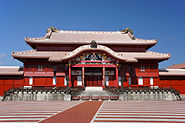| Ryūkyū Domain 琉球藩 | |||||||||
|---|---|---|---|---|---|---|---|---|---|
| Domain of Japan Tributary state of Qing China (until 1875) | |||||||||
| 1872–1879 | |||||||||
Mon of the Second Shō family
| |||||||||
 Ryukyu Domain included the southern-half of the Ryukyu Islands. | |||||||||
| Capital | Shuri Castle | ||||||||
| Government | |||||||||
| • Type | Monarchy | ||||||||
| Domain head | |||||||||
• 1872–1879 | Shō Tai | ||||||||
| Sanshikan | |||||||||
• 1872–1879 | Urasoe Chōshō | ||||||||
• 1875–1879 | Tomikawa Seikei | ||||||||
• 1877–1879 | Yonabaru Ryōketsu | ||||||||
| Historical era | Meiji period | ||||||||
• Established | 1872 | ||||||||
• Disestablished | 1879 | ||||||||
| |||||||||
| Today part of | Okinawa Prefecture | ||||||||
| History of Ryukyu |
|---|
  |
The Ryukyu Domain (琉球藩, Ryūkyū han) was a short-lived domain of the Empire of Japan, lasting from 1872 to 1879, before becoming the current Okinawa Prefecture and other islands[citation needed] at the Pacific edge of the East China Sea.
When the domain was created in 1872, Japan's feudal han system had developed in unique ways. The domain was a political and economic abstraction based on periodic cadastral surveys and projected agricultural yields.[1] In other words, the domain was defined in terms of kokudaka, not land area.[2] This was different from the feudalism of the West.
- ^ Mass, Jeffrey P. and William B. Hauser. (1987). The Bakufu in Japanese History, p. 150.
- ^ Elison, George and Bardwell L. Smith (1987). Warlords, Artists, & Commoners: Japan in the Sixteenth Century, p. 18.

